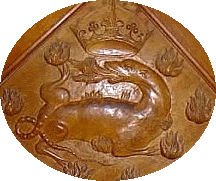François 1er
 |
 |
 |
Wire of Charles of Orleans, count d' Angoulême, head of Valois Angouleme and Louise of Savoy, François of Angouleme was born on September 12 1494 in Cognac (in Charente) in the family castle.
In 1514, François de Valois, marries the girl of Louis XII, Claude of France. But, when the king dies suddenly without male heir, it reaches the throne of France; by its advent, January 1 1515, the branch of Valois-Angouleme succeeds that of Valois-Orleans. The new king is crowned with the cathedral of Rheims on January 25.
Like his predecessors Charles VIII and Louis XII, François Ier dreams of Italy, country of the Rebirth. Hardly gone up on the throne, the young king launches his army towards Italy to take again the Milanese - that Louis XII had just lost little before his death - and gains the battle of Marignan into 1515.
Sovereign shining, typical monarch of the Rebirth, he is the friend of the painters, the architects and the sculptors. It is under its reign that Jacques Cartier leaves to discovered the mouths the SAINT LAURENT and inserts France in what will be Quebec.
It also poses the bases of the absolutism and endeavours to centralize its State.
In the field of the assistance, it creates " the large office of the poor " which levies a tax on the laic and ecclesiastical properties to feed a bottom of distribution of alms.
It imposes French like official language (to replace Latin) in the instruments by the ordinance of Villers-Cotterêts. This ordinance also forces the priests to hold in their parish, a register of the baptisms and burials. This measurement is at the origin of what is called the marital status.
The end of its reign is sullied by the massacre, in 1545, of deviationists Vaudois (about 3000 killed).
Mined by syphilis, this prince of the Rebirth, François die on July 31 1547 with the Castle of Rambouillet and are buried with his wife, Claude of France, duchess of Brittany, with the Saint-Denis basilica. His/her son Henri II succeeds to him.The salamander, emblème of François Ier, symbolizes the capacity on fire, therefore on the men and the world. The currency Nutrisco & extinguo ("I of nourished and I extinguish it"), who accompany sometimes this emblème, take all its direction when one refers to the capacity on fire.


